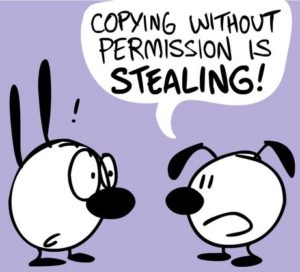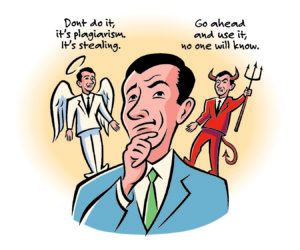The term ‘plagiarism’ has numerous vague and unclear definitions because of being rather problematic.
As there had been no notion of originality until the 18 century, the modern concept of this term is rather ambiguous. A Latin word “plagiarius” means stealing the work of another person. Most of the modern scientists agree that ‘plagiarism’ is a kind of fraud that may involve:
-
stealing of one’s ideas, expressions, thoughts, and words,
-
their use without source indication,
-
presentation of a new idea derived from the existing one as one’s original work,
-
avoidance of quotation marks etc.
In general, it is an immoral, dishonest and not ethical behavior of the person as he or she violates the law by stealing somebody’s intellectual property, though plagiarism is still not defined and punished by law. It is a popular term used in many institutions that punish “criminals” and their actions may result in penalties, suspension or expulsion from the educational establishments. Plagiarism also denotes a moral offense so it can be a reason to breach a contract or punish the violator.
There is another question: how to detect plagiarism as it is impossible to know everything available on the Web by heart. The easiest way is to use a Plagiarism checker: there are programs that can be installed on your PC or free online checkers.

Intentional vs. Accidental
Plagiarism is usually divided into intentional and accidental depending on the presence or absence of the person’s intention.
Intentional Appropriation
Sometimes writers want to present their point of view using words or examples of other authors. Though it may seem a public knowledge and a widely used fact, there is always an author of the original statement, which was later cut into small pieces or used by others. If you do know the author of the original quotation, it is always required to use quotation marks or credit the author to avoid plagiarism.
Dealing with plagiarism requires more than just detecting the problem, though. You also have to know how to respond to it. As a website owner, there are two types of intellectual property theft you might have to deal with. Find out more about Plagiarism in Blogging here.
In general, there are several types of intentional or deliberate plagiarism used by students, for example:
-
Presentation and handing in of the assignment written by another person;
-
Paying money to have your paper written;
-
Copy-paste parts or completely downloaded paper from the Internet;
-
Deliberate use of other people’s ideas, images, creations, thoughts without stating the source you took them from;
-
Passing off of the another person’s ideas as your own ones etc.
Example 1. Verbatim plagiarism, or unacknowledged direct quotation
Almost all of Shakespeare’s Hamlet can be understood as a play about acting and the theater. For example, there is Hamlet’s pretense of madness, the “antic disposition” that he puts on to protect himself and prevent his antagonists from plucking out the heart of his mystery. When Hamlet enters his mother’s room, he holds up, side by side, the pictures of the two kings, Old Hamlet and Claudius, and proceeds to describe for her the true nature of the choice she has made, presenting truth by means of a show. Similarly, when he leaps into the open grave at Ophelia’s funeral, ranting in high heroic terms, he is acting out for Laertes, and perhaps for himself as well, the folly of excessive, melodramatic expressions of grief.
Alvin Kernan, The Playwright as Magician. New Haven: Yale University Press, 1979. pp. 102–103.
From time to time this submerged or latent theater in Hamlet becomes almost overt. It is close to the surface in Hamlet’s pretense of madness, the “antic disposition” he puts on to protect himself and prevent his antagonists from plucking out the heart of his mystery. It is even closer to the surface when Hamlet enters his mother’s room and holds up, side by side, the pictures of the two kings, Old Hamlet and Claudius, and proceeds to describe for her the true nature of the choice she has made, presenting truth by means of a show. Similarly, when he leaps into the open grave at Ophelia’s funeral, ranting in high heroic terms, he is acting out for Laertes, and perhaps for himself as well, the folly of excessive, melodramatic expressions of grief.
Accidental Plagiarism
Some writers, especially ones studying in the higher educational institutions, get into a trap of accidental plagiarism – the situation when you copy-paste one’s point of view in your more sizable work without the intention to deceive, only because it suits your content perfectly. A couple of phrases, sentences, paragraphs copied both fully or partially even without the intention of lying or deception are still plagiarized and can be a reason of punishment and sanctions. Another more frustrating form of accidental plagiarism is the fact when your genuine thought is later noticed by you in one of the articles or papers written by other people. It may happen because our memory is not perfect and having once seen and read an interesting viewpoint we may forget that fact and in some time use this data as personally invented one.
There are also some other forms of accidental plagiarism such as:
-
A situation when you forgot where you had found information;
-
You paraphrase the text without paying attention to the origin of the material;
-
You omit quotation marks though admit that these words belong to another author etc.
Example 2. Lifting selected passages and phrases without proper acknowledgment
Almost all of Shakespeare’s Hamlet can be understood as a play about acting and the theater. For example, in Act 1, Hamlet adopts a pretense of madness that he uses to protect himself and prevent his antagonists from discovering his mission to revenge his father’s murder. He also presents truth by means of a show when he compares the portraits of Gertrude’s two husbands in order to describe for her the true nature of the choice she has made. And when he leaps in Ophelia’s open grave ranting in high heroic terms, Hamlet is acting out the folly of excessive, melodramatic expressions of grief.
Original source (text)
From time to time this submerged or latent theater in Hamlet becomes almost overt. It is close to the surface in Hamlet’s pretense of madness, the “antic disposition” he puts on to protect himself and prevent his antagonists from plucking out the heart of his mystery. It is even closer to the surface when Hamlet enters his mother’s room and holds up, side by side, the pictures of the two kings, Old Hamlet and Claudius, and proceeds to describe for her the true nature of the choice she has made, presenting truth by means of a show. Similarly, when he leaps into the open grave at Ophelia’s funeral, ranting in high heroic terms, he is acting out for Laertes, and perhaps for himself as well, the folly of excessive, melodramatic expressions of grief.

Identifying Plagiarism
- Gray Areas: Paraphrasing, Summarizing, and Common Knowledge
Taking into account that different dictionaries define plagiarism in various ways as well as the ambiguity of the term itself one should agree that plagiarism involves a wider list of immoral actions than simple copy-paste or non-quoted citation. Even if you steal a concept or idea and explain it with your own words, it means that your thought is not original. We spend years at school learning how to interpret or summarize the ideas of others not understanding that produced results are not our personal ones. Writing involves production and expression of your own ideas so customary for us paraphrasing, summarizing and the most ambiguous common knowledge categories are only gray areas of plagiarism and are included in the list of offenses connected with it.
Paraphrasing
Example 3. Paraphrasing the text while maintaining the basic paragraph and sentence structure
Almost all of Shakespeare’s Hamlet can be understood as a play about acting and the theater. For example, in Act 1, Hamlet pretends to be insane in order to make sure his enemies do not discover his mission to revenge his father’s murder. The theme is even more obvious when Hamlet compares the pictures of his mother’s two husbands to show her what a bad choice she has made, using their images to reveal the truth. Also, when he jumps into Ophelia’s grave, hurling his challenge to Laertes, Hamlet demonstrates the foolishness of exaggerated expressions of emotion.
Original source (text)
From time to time this submerged or latent theater in Hamlet becomes almost overt. It is close to the surface in Hamlet’s pretense of madness, the “antic disposition” he puts on to protect himself and prevent his antagonists from plucking out the heart of his mystery. It is even closer to the surface when Hamlet enters his mother’s room and holds up, side by side, the pictures of the two kings, Old Hamlet and Claudius, and proceeds to describe for her the true nature of the choice she has made, presenting truth by means of a show. Similarly, when he leaps into the open grave at Ophelia’s funeral, ranting in high heroic terms, he is acting out for Laertes, and perhaps for himself as well, the folly of excessive, melodramatic expressions of grief.
Summarizing
|
SPECIAL NOTES: This summary is very short because it was the first draft done by the student. (Note: It is in three paragraphs at present. However, it could be combined into one paragraph to provide a brief, one-paragraph Summary section at the beginning of a much longer formal academic paper, right after the introduction and before the body sections of the paper.)
University of Minnesota
Eng 3027-5, Advanced Composition
Rough-Draft Summary
© Min Seok KimScience Shows Us How the World Is
by Min Seok Kim“Is Science Dangerous?” by Lewis Wolpert appeared in the March 25, 1999 issue of Nature. In this article, Wolpert insists that scientific knowledge has no moral or ethical value, and that all it does is make a just society.
Wolpert tells us that we do not know the exact difference between science and technology. In actuality, science makes ideas about how the world works; scientists do not cause unethical behaviors. However, technology — such as the genetic engineering feats of human cloning, gene therapy, and genetically modified foods — can do so. Wolpert suggests some guidelines to reduce ethical problems: all scientific ideas should be criticized by others; knowledge should be used to do good, not evil; and government and the media should act correctly in carrying out the applications of science
In the article “Is Science Dangerous?” Lewis Wolpert explains that science itself is not dangerous, and the real danger depends on how safely science is applied — and on how we respond to it.
|
SPECIAL NOTES: The subtitles in this sample add clarity, but most instructors either do not require them and some may prefer that subtitles not be used in a short summary.
University of Minnesota
EngC 3027-5, Advanced Composition
Formal Summary
© Roger S. ThomasA Summary of “National Security Justifies Censorship”
by Roger S. ThomasIntroduction
The article “National Security Justifies Censorship” by Elmo R. Zumwalt and James G. Zumwalt, appears in Censorship, a book in the Opposing Viewpoints Series. The article asserts that information that is secret and vital to the security of the nation should not be released to the press. The arguments made by Zumwalt Senior and Junior are summarized below.
Summary
Although many journalists contend that the First Amendment guarantees unrestricted printing freedom, the authors believe the press has gained more power than the framers of the Constitution foresaw and therefore neglected to install safe guards that would protect national security. According to the authors, the power of the media has gone far past what the constitutional framers expected; consequently, several acts since the writing of the Constitution have been implemented to deal with the lack of protection regarding national security. The authors continue to affirm that even though significant risk exists when confidential information is released to the press, this danger has remained unresolved by the courts.
The authors cite an example to prove this point. The CIA during the Reagan administration recognized Muhamar Quadaffi as a known terrorist and a potential threat to national security in a classified document. The Washington Post somehow had the document disclosed to them, and they soon published the information. Several months after the operation had been abandoned, the CIA found Quadaffi responsible for the bombing of a West Berlin discotheque. Military action had to be taken because of the earlier release of the classified document. The operation incurred military casualties.
The authors then offer a two-part solution: (1) make the publication of classified information a punishable offense, and (2) incorporate a “code of ethics” into media guidelines that safeguards national security. The paper ends by discussing how ethics are the responsibility of good journalism.
Conclusion
Elmo R. Zumwalt and James G. Zumwalt assert that the media are overpowered and the national security is underprotected. They believe that the government and the media must take steps to assure a disaster does not occur.
Common knowledge
Examples of Common Knowledge
Not every fact in your paper needs to be documented. Facts that are widely known—common knowledge—can stand by themselves.
Examples of statements expressing common knowledge:
- George Washington was the first president.
- Plato spent most of his life in Athens.
- Maine has a lower yearly average temperature than Florida.
Any statement that originates from another source and contains information that is not common knowledge must be cited.
Examples of statements that don’t express common knowledge:
- Civilizations that were aware of geese usually considered them intermediaries between heaven and earth (Toussaint-Samat 352).
- The Chinese fishing industry produces 800,000 tons of fish annually (Toussaint-Samat 328).
- The first international coffee syndicate was based in Germany (Toussaint-Samat 590).
- To Cite or Not to Cite: The Common Knowledge Exemption
The citation is one of the best ways to avoid plagiarism and if you distinctly know, whose words you include in your written paper, you are obliged to cite them. But what should we do with another available for us information which is called a common knowledge? It is a very specific term that is difficult to explain as well as differentiate in the text. According to “the free dictionary”, it is “anything generally known to everyone”, while Wikipedia offers a more ambiguous definition including a phrase “with reference to the community in which the term is used”. According to the last definition, there is hardly any difference between the citation and common knowledge as there are quotes known almost by each person on the Earth. That is why it is better to understand this term as generally known information, though it can also sound not specific. Some people might know this information, the others may be unaware of some facts, but some factual information, as well as common expressions, are not considered stolen or plagiarized. The best example of such common information is provided in Wikipedia with all necessary references and citations of the unique and distinct products of other people that are referred to a particular work of an individual.
Paraphrasing and Summarizing: Danger Zones
Students and other not experienced writers always get confused if they are charged for paraphrasing and writing summaries. But let us look at the definitions of both these terms:
- Paraphrasing is the way to convey the meaning of the original text using other words.
- Summarizing is the presentation of the main points or content of the text in a brief and condensed manner.
Having read both of these definitions it becomes obvious that the original idea of the author will be stated in the newly written text and that is a bright example of plagiarism. To avoid any problems and misunderstandings it is always better to insert information about the author of the text in both of these pieces of writing or use citation.
- The “Patchwriting” Problem
One of the most serious problems of the information available on the Web is patchwriting. Let us consider what it is and why it is so problematic.
Patchwriting is a common writing technique that is similar to low-quality paraphrasing, when a writer focuses on the syntax and vocabulary of the original material but changes tenses and rearranges phrases there. Another definition of patchwriting focuses on the mixture of the material both original and plagiarized.
Consequently, more and more unique and exclusive information becomes common knowledge without the author’s agreement and what is more disappointing – it can even be not detected by plagiarism checker. As a result, soon it might be impossible to determine where original thoughts are and where there are no of them at all.
- Copyright Infringement vs. Plagiarism
Another form of plagiarism is copyright infringement – use of works or products that are subjected to copyright law without asking the permission of the author or copyright holder and by doing so depriving him or her of their official rights. Many people just call it piracy, theft or freebooting as this activity is illegal and such way of plagiarism can lead to a lawsuit and criminal or civil responsibility.
Best Practices: Avoiding Plagiarism
It is a talent to write unique texts and not every person can do that. But there are also some useful practices that may help avoid plagiarism for beginners. To create a high-quality product one should:
-
Be familiar or even professional in the sphere you talk about as too much reading may get your more inclined to retell or paraphrase the original source;
-
Always include bibliography, citation and quotation marks to sound persuasive and never forget to mention the source;
-
Make thorough planning and collect thoughts before you start writing to resist temptation to copy and paste;
-
Never omit the manual proofreading step;
-
Opt for plagiarism checker tools that may detect both intentional and accidental plagiarism.
Of course, to create exclusive pieces of writing one should have a desire to do that and be aware of what plagiarism is. These are the main practices that must be considered by every writer and the list mentioned higher will be very helpful to transform every text into a perfect one.
Latest posts by Noplag (see all)
- Periodix: intelligent job matching for freelancers | Noplag review - March 30, 2018
- Hard Work VS Talent: Who Beats Whom? - December 15, 2017
- Listening To Music While Doing Homework: Is It A Good Idea? - December 12, 2017



It bothers me when others do not provide proper attribution!
As a writer, I understand copyright, but most people don’t. 🙁